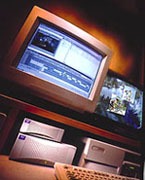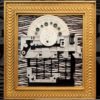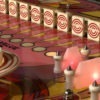
Non-linear Editing: Demystified
Written by Bob DiGregorio, Jr. from Waltham Community Access Corporation | Posted by: Anonymous
Non-linear editing: What is it?
If you have been producing film or video, you have probably run across the term "non-linear editing." In simplest terms, it can be described as being able to edit film or video footage in non-sequencial order. Traditionally, film editing has always been edited in a non-linear fashion as on a Movieola or Steinbeck. Videotape, on the other hand, has always been edited in a linear fashion.
Linear editing: How it differs.
Linear editing differs from non-linear in the sense that with linear editing, scenes have to be cut in sequence from beginning to end. For example, figure 1 shows the cut and paste ability non-linear editing has over linear editing. With non-linear editing, you can move different sequences of the same video piece into different locations within that same piece. On the other hand, with linear editing if you want to change the order of sequences you will have to re-edit the entire piece up until the point where you want to make the change.
Figure 1.

This simple difference may cost a producer to lose a significant amount of time and money. There’s usually a 3:1 ratio of time usage. That is to say, you can edit three versions of a project using non-linear editing in the amount of time it takes to edit only one version of a project using linear editing.
Non-linear editing components
All non-linear editing systems consist of a computer, video board, video editing software, audio editing software, external hard drive space, RAM, and video decks. The key is to select a computer with enough processing power, RAM, and external hard drive space.
There are many video boards on the market. In order to select the correct one, you need to know what formats you will be primarily digitizing. Video signals are either composite or component. The basic difference between composite and component is that composite is a combination of red, green, and blue signals while component is the isolation of red, green, and blue signals. AVID and Media100 are able to utilize both composite and component. Truevision (makers of the most popular consumer video capture boards) makes two types of boards. The Targa 2000 is the composite version and the Targa 2000 Pro is the component version. Both The Targa 2000 and 2000 Pro are Super VHS compatible. (Formats that are considered composite are VHS, 3/4"and Hi8. Formats that are considered component are Beta, BetaSp and Digital Beta.) Super VHS is its own format because it is a combination of composite and component. SVHS actually splits the black-and-white and color signals, therefore, SVHS will have adjustable levels for color and black-and-white. All consumer video boards are SVHS compatible.
With respect to software, there are many different software programs available. For example, AVID and Media100 systems utilize proprietary compression, and they will supply you with their own video capture boards, software, and hard drive space. This means that their video boards are exclusive to their hardware and software. Another option is to purchase a Targa 2000 video capture board with Adobe Premiere and begin editing.
For those of you who prefer a practical learning environment, AVID and Media100 have editing courses available for their particular software. Course information is available via their websites (http://www.avid.com and http://www.media100.com).
Digitization, what is it and how can it be done?
Another important aspect of non-linear editing is digitization. Digitization is transforming analog footage into digital information. This process is real time and can not be accelerated. For example, if you have a three-minute clip, it will take three minutes to digitize. There are also different ways video boards digitize footage. Both AVID and Truevision utilize a RGB architecture, which was designed to support computer displays and in which multiple colorspace conversions are required. As a result, the AVID and Truevision RGB systems can introduce errors that can cause image degradation. In contrast, Media100 utilizes true digital video architecture within YCrCb colorspace. By using this architecture, Media100 can eliminate conversions that degrade signal code and colorspace.1 Despite these differences, AVID, Media100, and Truevision are considered broadcast quality.
Editing with non-linear
Although, non-linear editing still involves using basic editing theory and applications, one of the advantages of non-linear editing is its flexibility. As we know, clients tend to change their minds quite a bit in the editing room. With non-linear editing, you can make the changes as fast as the client can think of them and never have to go back and start from scratch. Also, you can save multiple versions of a project so a client can see the difference between ideas.
The ability to bring digital information into a number of different programs is called integration. Integration is another key element in non-linear editing. Integration will allow photographs and video clips to be creatively manipulated by programs such as Adobe PhotoShop, Adobe After Effects, AVID Elastic Reality and Strata Media Paint. With this ability, editors have to be concerned with rendering times. Rendering time refers to the amount of time it takes the computer to process your manipulated image(s).
Higher end systems such as AVID and Media100 can be considered "real-time," depending on the complexity of your editing. For instance, no rendering time is involved when you are editing one sequence after another using simple cuts, dissolves or wipes. However, if you have created complex 2D or 3D effects, then you will need some time to render that particular effect. Rendering times vary in relation to the complexity and length of the sequence, as well as, the computer processing speed. As a rule, 2D animations take less time to render than 3D animations.
Non-linear editing systems: purchase or rent?
Both AVID and Media100 have on-line systems available to purchase. These systems are expensive and may be cost-prohibitive to purchase. AVID has released MCXpress for both MAC and PC for approximately $10,000. For you to get started at home, you will also need a computer, a video capture card that is compatible with your computer choice, plenty of hard drive space and RAM, editing programs, and video decks for an additional $10,000.
AVID and Media100 systems are available to rent through Rule Broadcasting. For more information on rental rates, you may refer to Rule’s web site at http://www.rule.com.
If you want to go to a production house to edit, I have provided a list of post houses with a description of their service and rates.
Summary
Non-linear editing really boils down to being able to edit any segment, at any point, at any time in the project. You can cut & paste, manipulate video clips and pictures, and save multiple versions in the same amount of time it would take to edit one version by traditional linear means.
List of Post Houses with Rates
Auto Edit
617-492-8286 Barry O’Brien
90 Hamilton Street
Cambridge, MA 02139
AVID 1000 with 36 gigs and a Mackie outboard audio board.
Basic rate is $850.00 per day add $30.00 to $50.00 dollars per hour for an editor
Auto Edit will also cut rates for a long edit. If a producer is editing for five days, Auto Edit will charge them for three and give them two days free. It is called it three = five.
Also, Auto Edit has a partnership with Bill Wagner & Associates, which is an audio production facility. Bill Wagner’s studio is tied into Auto Edit’s AVID suite, so a producer can do audio sweetening and production. The cost is $95.00 per hour for this service.
![]()
Boston Post Production
617-67-0500 Franchesica
648 Beacon Street
Boston, MA 02215
Avid 1000 with 36 or 42 gigs
Digitizing has two options:
Option 1: Unsupervised is $50.00 per hour
Option 2: Supervised is $ 100.00 per hour
Off-line AVR 2 is $150.00 per hour (low resolution)
On-line AVR 27 is $195.00 per hour (high resolution)
May record to Beta SP or D-Beta
![]()
CF
617-924-3737 Kerry Green
44 Pleasant Stret
Watertown, MA 02172
AVID 8000 ver 5.5 with 9 gigs AVR26
High or Low resolution is $1,200.00 per day with editor. Note, you cannot bring your own editor when working with the AVID 8000.
Digitizing low resolution is $65.00 per hour. High resolution is $130.00 per hour.
AVID 1000 is $800.00 per day for digitizing and possibly off-line editing.
If you have a project that utilizes CF’s whole facility, they will give you a percentage discount depending on the scope of the project and how much of their facility you incorporate (graphics, audio, animation, etc.).
![]()
Cramer
781-255-8400 x224 Ann Cave
425 University Avenue
Norwood, MA 02062
Avid 8000 and Media 100 rates are the same. They typically use the Media 100.
Digitizing and off line rate is $75.00 per hour with no editor
On line is $175.00 per hour with an editor.
They are willing to work something out with producers to make life easy and keep their budgets down. Also, they have evening rates. Call Ann for specific rate information.
![]()
National Boston Video Center 617-734-4800 Sherri Sklar
115 Dummer Street
Brookline, MA 02146
AVID 1000
Low resolution $250.00 per hour with an editor
High resolution $310.00 per hour with editor
Digitizing starts at $200.00 per hour, price is negotiable per project.
If you bring in an editor the cost would be $1,500.00 per day.
![]()
New England Business Television Services
617-578-4287 Julie Avard
P.O. Box 9121, 501 Boylston Street
Boston, MA 02116
They are not a digital suite. They edit beta to beta or 1." The rate for this is $225.00 per hour with an editor.
Studio rental is available. 26×32 studio fully equipped with cameras, audio, graphics, and lighting grid. Control room and make-up rooms are available as well. They also provide casting services, graphic design, and animation designers.
![]()
Ocean One
617-266-1117 Dan Fickes
116 Newbury Street
Boston, MA 02116
AVID 1000 w/ Avr26 (with plans to upgrade to Avr75) and 27gigs of hard drive space.
Digitizing rate is $75.00 per hour.
Off Line and On Line is $150.00 per hour w/ editor
Beta editing is $160.00 per hour
3 decks, DVE and graphics
Willing to work out deals for producers who bring in their own editor or edit off hours.
![]()
Rampion Visual Productions
617-574-9601 Steve or Joe
316 Stuart Street
Boston, MA 02116
Media 100
Digitizing is $100.00 per hour
Off and On line is $150.00 per hour with an editor. (They don’t allow freelance editors)
Animation and graphics will be around $200.00 per hour.
![]()
Shockwave Productions
781-894-0064 Dave Foucher
738 Main Street, #229
Waltham, MA 02154
Media 100
Digitizing and Off line editing is $80.00 per hour with an editor
On line editing is $120.00 per hour with an editor
They do not allow freelance editors.
A typical day is 10 hours.
![]()
Wave
508-626-9900 Steve Wade
11 California Avenue
Framingham MA 01701
Digitizing is $75.00 per hour
Off Line low resolution is $100.00 per hour
Off Line high resolution is $120.00 per hour
On Line Beta SP is $150.00 per hour
On Line D Beta is $160.00 per hour
(above pricing includes an editor)
6:00 PM to 6:00 AM rates are listed below:
Digitizing is $60.00 per hour
Off Line low rez is $80.00 per hour
Off Line high rez is $95.00 per hour
On Line Beta SP is $120.00 per hour
On Line D Beta is $130.00 per hour
(above pricing includes an editor)
* all above prices are discount rates for producers just editing at Wave
Worden, Curt Group Inc.
508-636-6166 Kim
226 Gaffney Road
South Dartmouth, MA 02748
AVID is $300.00 per day Digitizing, Off line or On line 7:00 AM to 9:00 PM
AVID is $40.00 per hour Digitizing, Off line or On line form 9:00 PM to 7:00 AM
An editor will typically cost between 40 to 60 dollars per hour.
1 Kroeker, Edwin. Pristine Images-Relating Broadcast-Standard YCrCb Signal Processing To Image Quality. http://www.media100.com/techinfo.html 1996 Multimedia Group.










